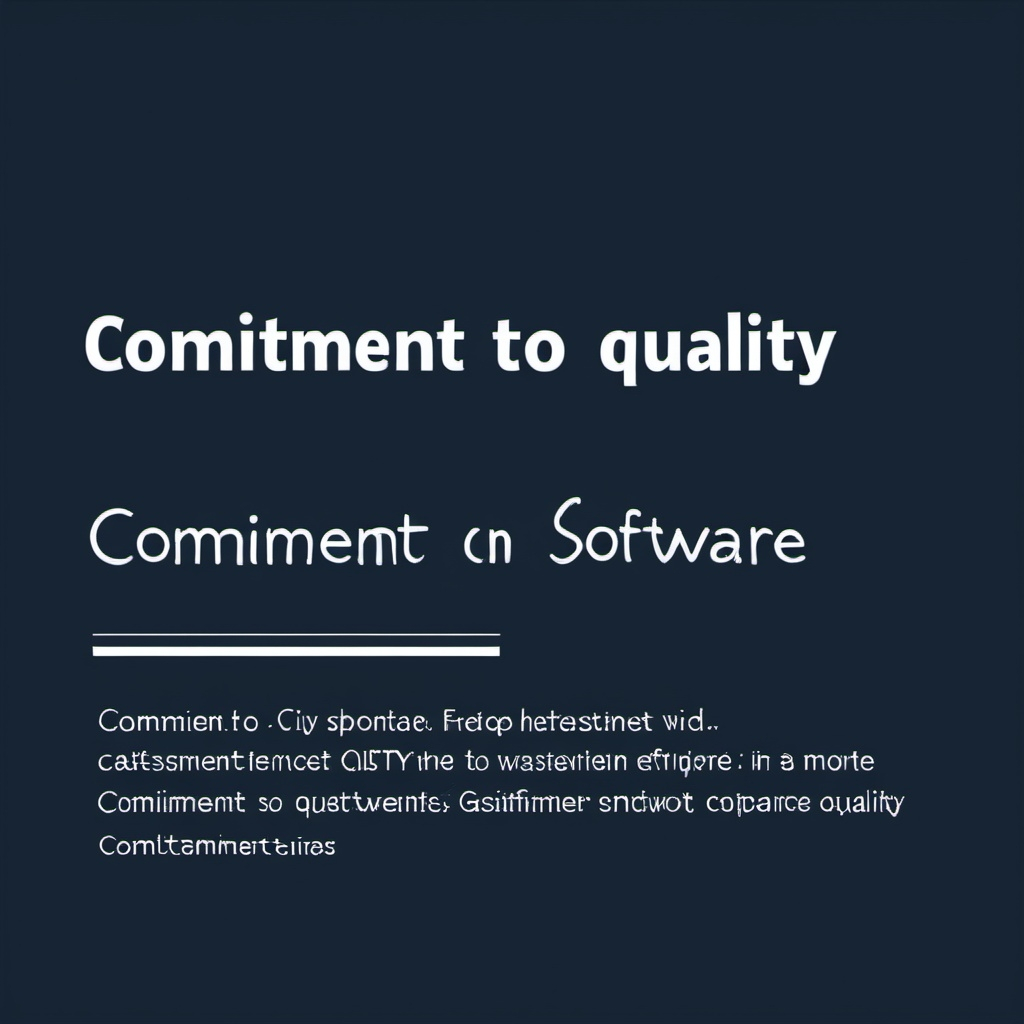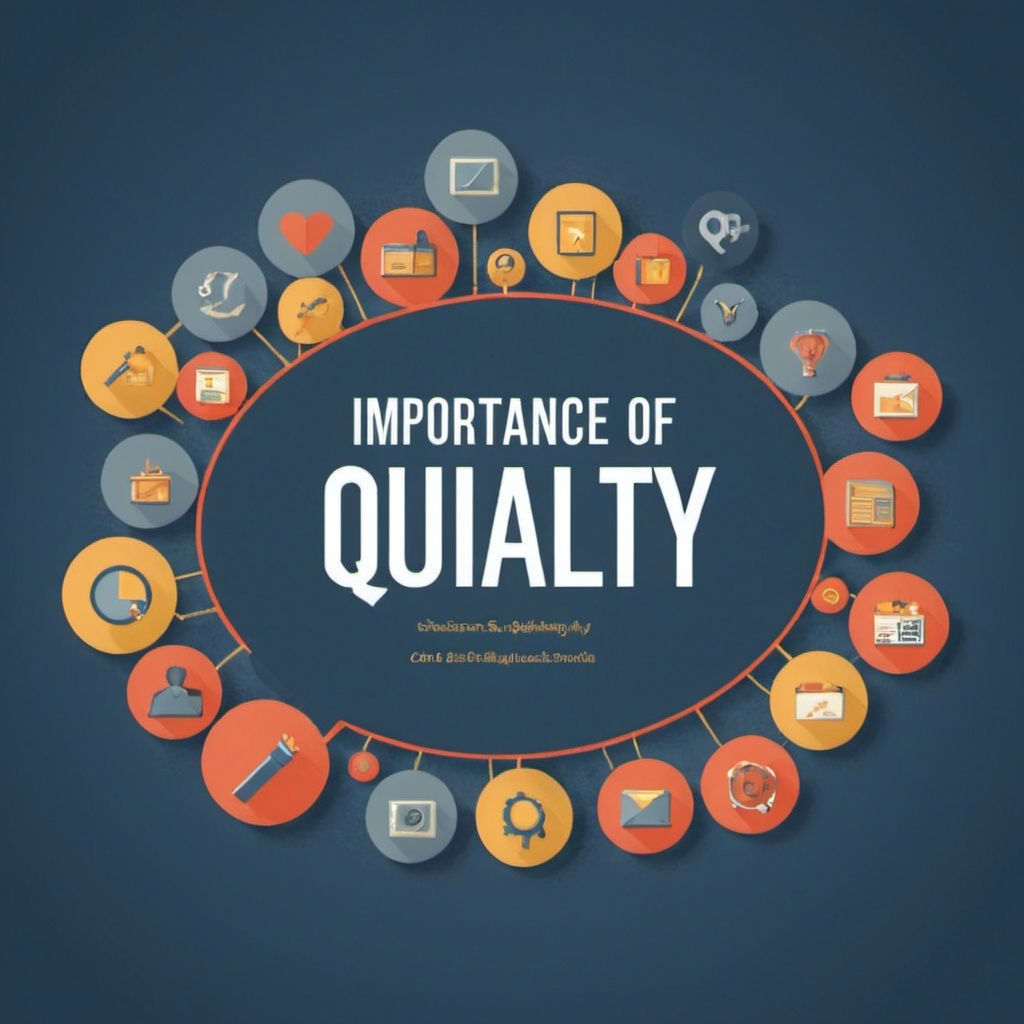Digital landscape has more rapidly evolved than ever, software has become an integral part of almost every aspect of our lives, from the devices we use to communicate to the systems that manage essential services. As the reliance on software continues to grow, so does the importance of ensuring that it is of the highest quality. Software quality is not just a technical requirement; it is a commitment to delivering reliable, efficient, and secure solutions that meet the needs of users and stakeholders.
Quality in software is multifaceted, encompassing various attributes such as functionality, reliability, usability, performance, and security. A commitment to quality in software means that developers, testers, and other stakeholders prioritize these attributes throughout the software development lifecycle. This commitment is not just about preventing defects or meeting basic requirements; it is about striving for excellence in every aspect of the software.
The significance of software quality is evident in the potential consequences of neglecting it. Poor-quality software can lead to system failures, security breaches, user dissatisfaction, and financial losses. On the other hand, high-quality software can enhance user experience, build trust, and contribute to the success of a business. Therefore, commitment to quality is not just a technical obligation but a business imperative.
In this article, we will explore the various dimensions of software quality, the practices that contribute to maintaining high standards, and the challenges that organizations face in their pursuit of quality. We will also discuss the importance of a quality-focused culture within software development teams and how commitment to quality can lead to long-term success.
What is Software Quality?
Software quality refers to the degree to which a software product meets the specified requirements, as well as the needs and expectations of its users. It is a measure of how well the software performs its intended functions, how reliable it is, how easy it is to use, and how secure it is from potential threats. In essence, software quality is about delivering a product that not only works but works well.
There are several key attributes of software quality:
- Functionality: This is the core of software quality. The software must perform the functions it is designed to do. It must be accurate, complete, and compliant with all specified requirements.
- Reliability: Reliable software consistently performs its intended functions without failure. It should be able to handle errors gracefully and recover from failures with minimal disruption.
- Usability: Usability refers to how easy and intuitive the software is for users. Good usability ensures that users can effectively and efficiently achieve their goals with the software.
- Performance: This attribute measures how well the software performs under various conditions. It includes response times, processing speed, and resource utilization.
- Security: In today’s world, security is a critical aspect of software quality. The software must protect against unauthorized access, data breaches, and other security threats.
- Maintainability: High-quality software is easy to maintain and update. It should be structured in a way that allows for easy modifications, bug fixes, and improvements.
- Portability: This attribute refers to the software’s ability to function across different environments, such as different operating systems or hardware platforms.
The Importance of Commitment to Quality
Commitment to quality in software development is essential for several reasons:
- User Satisfaction: High-quality software meets user needs and expectations. When users are satisfied with the software, they are more likely to continue using it and recommend it to others.
- Trust and Credibility: Organizations that consistently deliver high-quality software build trust and credibility with their customers. This can lead to long-term relationships and repeat business.
- Reduced Costs: Poor-quality software often requires costly fixes and updates after it has been released. By committing to quality from the beginning, organizations can reduce the likelihood of defects and minimize the need for expensive rework.
- Compliance and Security: Many industries have strict regulations and security standards that software must comply with. A commitment to quality ensures that software meets these requirements, reducing the risk of legal and financial penalties.
- Competitive Advantage: In a crowded market, high-quality software can differentiate a company from its competitors. Quality can be a key factor in winning customers and gaining a competitive edge.
- Long-Term Success: Quality is not just about short-term gains; it is about building a foundation for long-term success. High-quality software is more likely to be scalable, maintainable, and adaptable to future needs.
Practices That Contribute to Software Quality
Achieving high-quality software requires a combination of practices and methodologies throughout the software development lifecycle. Here are some key practices that contribute to maintaining high standards of quality:
- Requirements Gathering and Analysis: The foundation of software quality lies in accurately capturing and understanding the requirements. This involves clear communication with stakeholders, thorough analysis of user needs, and careful documentation of requirements.
- Design and Architecture: A well-thought-out design and architecture are essential for ensuring that the software is scalable, maintainable, and efficient. Good design practices include modularity, separation of concerns, and adherence to design patterns.
- Coding Standards and Best Practices: High-quality code is clean, readable, and maintainable. Adhering to coding standards, using best practices, and conducting regular code reviews help ensure that the codebase is of high quality.
- Automated Testing: Automated testing is a key practice for maintaining software quality. By automating tests, developers can quickly identify and fix defects, ensure that changes do not introduce new issues, and continuously validate the software against its requirements.
- Continuous Integration and Continuous Deployment (CI/CD): CI/CD practices enable teams to integrate and deploy code changes more frequently and reliably. This reduces the risk of defects and ensures that the software is always in a releasable state.
- Code Reviews and Pair Programming: Code reviews involve having peers review each other’s code to catch defects, ensure adherence to standards, and share knowledge. Pair programming, where two developers work together on the same code, is another practice that can enhance code quality.
- Performance Testing: Performance testing involves evaluating the software’s performance under various conditions, such as different loads and environments. This helps identify bottlenecks and areas for optimization.
- Security Testing: Security testing is crucial for identifying vulnerabilities and ensuring that the software is protected against potential threats. This includes penetration testing, code analysis, and vulnerability assessments.
- User-Centered Design and Usability Testing: Usability testing involves evaluating the software from the user’s perspective. By involving users in the design and testing process, developers can ensure that the software is intuitive and meets user expectations.
- Documentation and Knowledge Sharing: Good documentation is essential for maintaining software quality. This includes documenting requirements, design decisions, code, and test cases. Knowledge sharing within the team also helps ensure that everyone is aligned on quality goals.
The Role of Leadership in Commitment to Quality
Leadership plays a critical role in fostering a commitment to quality within a software development team. Without strong leadership, quality initiatives may lack direction, resources, and support. Here are some ways in which leadership can influence the commitment to quality:
- Setting Clear Expectations: Leaders must set clear expectations for quality and communicate them to the team. This includes defining quality standards, setting goals, and establishing metrics for measuring success.
- Providing Resources and Training: Quality initiatives require resources, including tools, training, and time. Leaders must ensure that the team has access to the necessary resources to achieve high-quality results.
- Encouraging a Quality-Focused Culture: A culture of quality is one where everyone on the team takes ownership of quality and strives for excellence. Leaders can foster this culture by promoting collaboration, recognizing achievements, and encouraging continuous improvement.
- Supporting Continuous Learning and Improvement: Quality is not a one-time achievement; it requires continuous learning and improvement. Leaders should encourage the team to stay up-to-date with the latest practices, technologies, and trends in software quality.
- Aligning Quality with Business Goals: Quality should be seen as a business priority, not just a technical one. Leaders must align quality initiatives with business goals and demonstrate how quality contributes to the overall success of the organization.
Challenges in Maintaining Software Quality
Despite the best efforts, maintaining software quality is not without its challenges. Some common challenges include:
- Time and Budget Constraints: Tight deadlines and limited budgets can pressure teams to cut corners on quality. Balancing the need for speed with the commitment to quality is a constant challenge.
- Changing Requirements: Software requirements often change during the development process, making it difficult to maintain quality. Managing these changes while ensuring that the software remains reliable and functional is a challenge.
- Technical Debt: Over time, software can accumulate technical debt, which refers to the shortcuts and compromises made during development. Technical debt can hinder quality and make the software more difficult to maintain.
- Complexity: Modern software systems are often complex, with many interconnected components. Ensuring quality across such a complex system requires careful planning, testing, and coordination.
- Security Threats: The ever-evolving nature of security threats poses a constant challenge to maintaining software quality. Keeping the software secure requires continuous vigilance and proactive measures.
- Communication Gaps: Effective communication is essential for maintaining quality. Miscommunication between team members, stakeholders, or customers can lead to misunderstandings, missed requirements, and defects.
Building a Quality-Focused Culture
In the world of software development, delivering high-quality products is not solely the responsibility of developers or quality assurance teams. It requires a collective effort from everyone involved, from top executives to individual contributors. Building a quality-focused culture is essential for ensuring that quality becomes a core value ingrained in every aspect of the organization. This culture fosters an environment where excellence is not just a goal but a continuous journey of improvement and innovation.
A quality-focused culture emphasizes the importance of delivering products that meet or exceed customer expectations. It involves creating a work environment where quality is prioritized, mistakes are viewed as learning opportunities, and everyone is empowered to contribute to the success of the product. This article explores how organizations can build and sustain a culture that prioritizes quality, the benefits of such a culture, and the challenges that may arise in the process.
Key Elements of a Quality-Focused Culture
- Leadership Commitment
The commitment to quality must start at the top. Leaders play a crucial role in setting the tone for the entire organization. They need to demonstrate their dedication to quality through their actions, decisions, and communication. This includes setting clear expectations for quality, allocating resources for quality initiatives, and actively participating in quality improvement efforts. Leadership support also involves recognizing and rewarding team members who contribute to high-quality outcomes, thereby reinforcing the value of quality within the organization.
- Clear Vision and Values
A quality-focused culture requires a clear vision and well-defined values that emphasize the importance of quality. This vision should articulate the organization’s commitment to excellence and serve as a guiding principle for all activities. Values such as integrity, accountability, and continuous improvement should be embedded in the organization’s mission statement and reflected in daily practices. Communicating these values consistently helps align the entire team with the goal of delivering high-quality products.
- Open Communication
Effective communication is fundamental to building a quality-focused culture. Open communication channels allow team members to share their ideas, concerns, and feedback. This openness fosters collaboration and ensures that potential quality issues are identified and addressed early in the development process. Regular meetings, feedback sessions, and transparent reporting mechanisms help maintain clear and continuous communication across all levels of the organization.

- Empowerment and Ownership
Empowering employees to take ownership of their work is crucial for fostering a culture of quality. When team members feel responsible for the quality of their contributions, they are more likely to take pride in their work and strive for excellence. Providing opportunities for professional development, involving employees in decision-making processes, and encouraging them to take initiative all contribute to a sense of ownership. This empowerment not only enhances motivation but also drives a commitment to maintaining high standards of quality.
- Continuous Improvement
A quality-focused culture is characterized by a commitment to continuous improvement. Organizations should adopt practices and processes that encourage ongoing evaluation and enhancement of their products and procedures. This includes implementing feedback loops, conducting regular performance reviews, and embracing a mindset of learning and adaptation. Encouraging teams to experiment with new ideas, learn from mistakes, and refine their approaches helps drive innovation and ensures that quality remains at the forefront of the development process.
- Customer-Centric Approach
Placing the customer at the center of the quality focus is essential for building a culture that truly values quality. Understanding and addressing customer needs and expectations should be a primary goal of the organization. Gathering customer feedback, conducting usability studies, and involving customers in the development process provide valuable insights into how well the product meets their requirements. A customer-centric approach ensures that quality is not just defined by internal standards but also by the satisfaction and experience of the end users.
- Quality Metrics and Standards
Establishing clear metrics and standards for quality helps organizations measure and track their performance. Quality metrics such as defect rates, customer satisfaction scores, and performance benchmarks provide objective criteria for evaluating the success of quality initiatives. Setting and monitoring these standards helps identify areas for improvement and ensures that quality goals are being met. Regularly reviewing these metrics and making necessary adjustments keeps the focus on maintaining and enhancing quality.
- Collaboration and Teamwork
Collaboration and teamwork are integral to building a quality-focused culture. Encouraging cross-functional collaboration between development, testing, and other teams ensures that all perspectives are considered in the pursuit of quality. Collaborative practices such as pair programming, joint problem-solving sessions, and knowledge sharing help improve communication and coordination. By working together, teams can identify and address quality issues more effectively and create solutions that meet the highest standards.
Benefits of a Quality-Focused Culture
- Enhanced Product Quality
A quality-focused culture leads to improved product quality. By prioritizing quality throughout the development process, organizations can reduce defects, enhance performance, and deliver products that meet or exceed customer expectations. This not only increases customer satisfaction but also strengthens the organization’s reputation for excellence.
- Increased Efficiency and Productivity
When quality is embedded in the culture, teams work more efficiently and effectively. Clear processes, well-defined standards, and effective communication reduce the likelihood of rework and errors. This leads to faster development cycles, higher productivity, and more efficient use of resources.
- Higher Employee Engagement and Satisfaction
Employees who feel empowered and valued are more engaged and satisfied with their work. A quality-focused culture provides opportunities for professional growth, recognition, and meaningful contributions. This leads to higher morale, lower turnover rates, and a more motivated workforce.
- Strengthened Customer Relationships
By focusing on delivering high-quality products that meet customer needs, organizations build stronger relationships with their customers. Satisfied customers are more likely to become loyal advocates, provide positive referrals, and contribute to long-term business success.
- Reduced Costs and Risks
Investing in quality from the outset helps reduce the costs associated with defects, rework, and customer complaints. By addressing quality issues early and continuously improving processes, organizations can minimize risks and avoid costly mistakes.

Challenges in Building a Quality-Focused Culture
- Resistance to Change
Building a quality-focused culture often involves changing existing practices and mindsets. Resistance to change can be a significant challenge, particularly if employees are accustomed to established ways of working. Overcoming this resistance requires effective change management strategies, clear communication, and leadership support.
- Resource Constraints
Implementing and maintaining a quality-focused culture requires resources, including time, personnel, and budget. Organizations may face constraints that limit their ability to invest in quality initiatives. Balancing these resource constraints with the need for quality improvement is a common challenge.
- Consistency Across Teams
Maintaining consistency in quality standards across different teams and projects can be challenging. Ensuring that all teams adhere to the same quality metrics, processes, and practices requires coordination and oversight. Developing standardized processes and promoting cross-team collaboration helps address this challenge.
- Balancing Speed and Quality
In a fast-paced development environment, balancing the need for speed with the commitment to quality can be difficult. Pressure to meet deadlines and deliver results may lead to compromises in quality. Finding the right balance requires careful planning, prioritization, and effective project management.
- Measuring Quality Effectively
Measuring and evaluating quality can be complex, as it involves various metrics and subjective criteria. Ensuring that quality metrics are meaningful, relevant, and accurately reflect the product’s performance is essential for effective measurement. Regularly reviewing and refining these metrics helps ensure their effectiveness.
Strategies for Sustaining a Quality-Focused Culture
- Regular Training and Development
Ongoing training and development are crucial for sustaining a quality-focused culture. Providing employees with opportunities to enhance their skills, stay updated on best practices, and learn about new tools and technologies helps maintain high standards of quality.
- Recognition and Reward
Recognizing and rewarding employees for their contributions to quality reinforces the importance of excellence. Celebrating successes, acknowledging achievements, and providing incentives for high-quality work help motivate and engage team members.
- Continuous Feedback
Regular feedback is essential for continuous improvement. Implementing feedback mechanisms such as surveys, reviews, and one-on-one discussions allows employees to share their perspectives and identify areas for improvement. Actively addressing feedback and making necessary changes demonstrates a commitment to quality.
- Leadership Visibility
Leaders should remain visible and actively involved in quality initiatives. Their presence and engagement signal the importance of quality and provide support for ongoing efforts. Leadership involvement also helps address any issues or challenges that arise and reinforces the organization’s commitment to excellence.
- Promoting a Learning Culture
Encouraging a culture of learning and innovation helps sustain a focus on quality. Providing opportunities for employees to experiment, explore new ideas, and learn from mistakes fosters a mindset of continuous improvement. Embracing a learning culture ensures that quality remains a dynamic and evolving priority.
Conclusion
Building and sustaining a quality-focused culture is essential for achieving long-term success in software development. By embedding quality into every aspect of the organization, from leadership to individual contributions, organizations can deliver products that meet high standards and exceed customer expectations. A quality-focused culture not only enhances product quality but also drives efficiency, engagement, and customer satisfaction.
While building such a culture presents challenges, the benefits of a strong commitment to quality are well worth the effort. By focusing on clear vision and values, open communication, empowerment, continuous improvement, and a customer-centric approach, organizations can create an environment where quality thrives. With ongoing support, recognition, and a dedication to learning, a quality-focused culture can become a cornerstone of organizational success and innovation.

Ultimately, a commitment to quality is an investment in the long-term success of the organization. It enhances user satisfaction, builds trust, and contributes to overall business success. By embracing a culture of quality and continuously striving for improvement, organizations can navigate the complexities of software development and deliver exceptional products that stand the test of time.
Curated reads





Hi my family member! I want to say that this article is amazing, nice written and include approximately all significant infos. I¦d like to see extra posts like this .
Thanks for another informative site. Where else could I get that type of information written in such an ideal way? I have a project that I am just now working on, and I have been on the look out for such information.
Thanks for some other wonderful article. Where else may anyone get that kind of info in such an ideal manner of writing? I’ve a presentation subsequent week, and I am on the search for such information.
I truly appreciate your technique of writing a blog. I added it to my bookmark site list and will
Business dicker I truly appreciate your technique of writing a blog. I added it to my bookmark site list and will
Thank you @businessdicker. I have seen your blog which looks good.
Pretty! This has been a really wonderful post. Many thanks for providing these details.